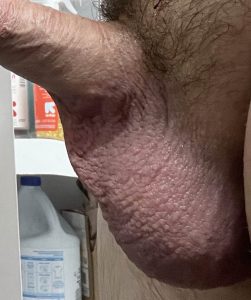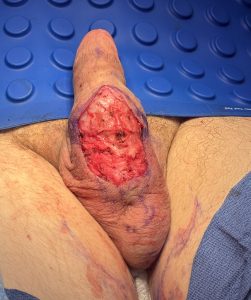Background: Penoscrotal webbing (PSW), also called a webbed penis, is when there is excessive skin between the penis and the scrotum. As a result a skin web appears when the penis is lifted up to 90 degrees or higher. Due to its appearance it could be called the turkey neck of the penis. Careful assessment of this skin web shows that it is typically scrotal skin that is attached too high on the underside of the penis. There are numerous causes of this type of penile turkey neck from natural congenital development, an over aggressive circumcision or large amounts of weight loss.
There are no non-surgical methods of getting rid of a webbed penis. The only way to improve its appearance is by removing the turkey neck through surgical excision. Numerous techniques have been described to do so with the main objective of not creating a scar contracture across the penile scrotal junction. There is no absolute best way to excise the penile turkey neck but in most cases the webbed skin excess is oriented longitudinally resulting in a straight line closure. Whether a concomitant z-plasty is performed at the penile-scrotal junction depends on the amount of web excision needed and the tension across the penile-scrotal junction.



Key Points:
1) The webbed penis has excessive skin that obliterates a well defined penile-scrotal junction in the erect or lifted penile position.
2) Excision of the penile turkey neck provides an immediate and permanent correction.
3) The excisional pattern of the webbed penis repair may result in a straight line closure which has some risk of scar hypertrophy and the potential need for secondary scar revision.
Dr. Barry Eppley
World-Renowned Plastic Surgeon





